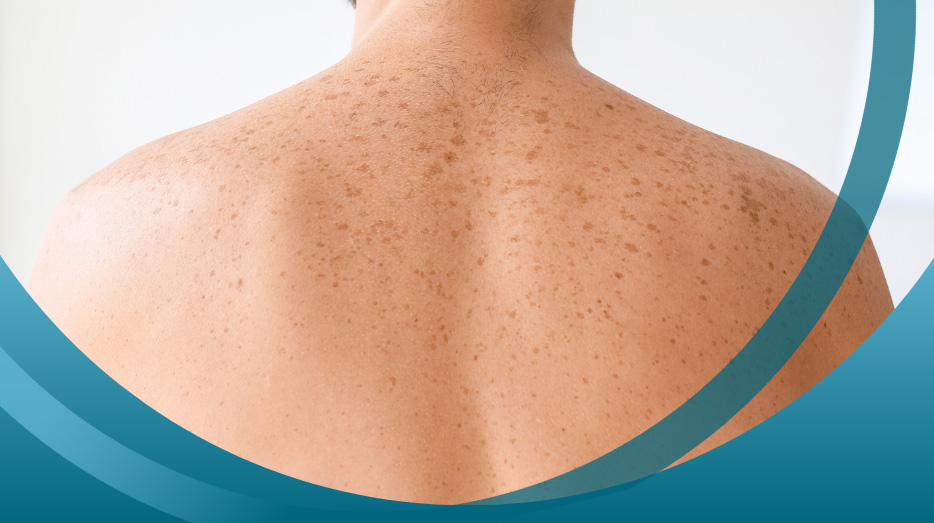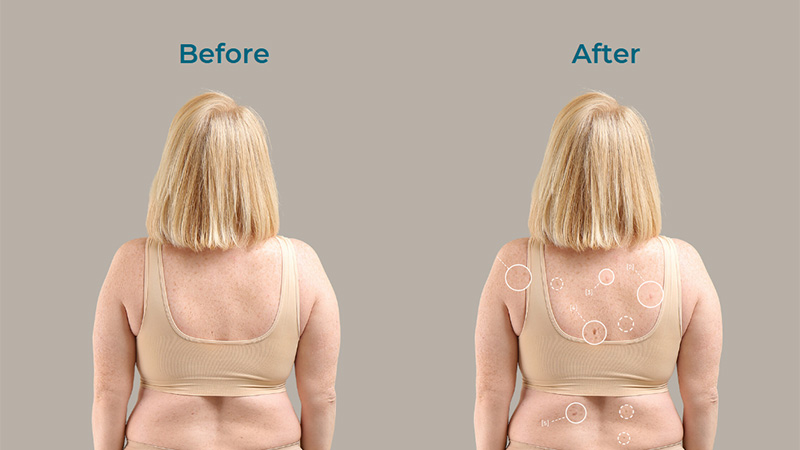Early detection is key in managing skin health, especially when it comes to identifying and treating skin cancer. At Skintel, we use high-tech, non-invasive methods – dermoscopy and optical biopsy – to assess skin lesions. Let’s take a closer look.
What is dermoscopy?
A dermascope is a hand-held tool that combines a high-quality magnifying glass with a powerful polarised light. We use this to examine your skin closely as it provides far more detail than the naked eye can see and allows us to see your skin’s underlying structures.
At Skintel, you’re fully clothed for this, as you’ve already had a whole body scan using our body map. Based on the results of your body map, your melanographer may wish to examine a few moles more closely. They’ll ask you to roll a sleeve up or lift your shirt briefly while they assess the relevant moles but you won’t need to strip down to your underwear as you do at other clinics.
Dermoscopy helps us to:
- Identify benign conditions like seborrheic keratosis
- Spot pre-cancerous chances such as actinic keratosis
- Identify potential cancers such as:
- Basal cell carcinoma – a very common form of skin cancer
- Melanoma or amelanotic melanoma.
The results of your dermoscopy guide the next steps of your treatment. We may recommend:
- No further action at this stage – continue to protect yourself from the sun and consider another skin check in a few years’ time
- Optical biopsy.
What is optical biopsy?
Some patients are referred to us for optical biopsy specifically. Others come for a comprehensive skin check, starting with a mole map and dermoscopy, then progress to an optical biopsy.
Optical biopsy is a game-changer in skin cancer diagnosis. It really does allow us to see skin differently.
For most patients (but not all), optical biopsy removes the need for invasive surgical biopsies which can result in scarring – something you may wish to avoid if you have a concerning mole on your face, for example.
Again, you’ll be fully dressed, only needing to adjust clothing to allow us to see the mole(s) in question.
Thanks to its 500x magnification, optical biopsy enables us to explore beneath the surface of your skin in 3D. It requires no cutting and therefore completely avoids issues relating to pain or scarring.
Best of all, you get an immediate answer. With a surgical biopsy, you face a rather anxious 1-2 week wait for results, wondering all the while if you’re facing skin cancer. Optical biopsy means your doctor can tell you there and then whether a particular mole is benign or malignant.
Benefits of early detection with dermoscopy and optical biopsy
Both dermoscopy and optical biopsy support the early detection of skin cancer, protecting your health and potentially your life.
When skin cancer is found early, you usually have a wider choice of treatments and greater chances of success.
Enter the new era of skin cancer diagnosis at Skintel
If you’re concerned about a particular skin lesion or simply think it’s time for a skin check, please book an appointment.
Disclaimer
All information is general and not intended as a substitute for professional advice.
References
- Australasian College of Dermatologists, Seborrhoeic keratoses, https://www.dermcoll.edu.au/atoz/seborrhoeic-keratoses/, [Accessed 12 November 2024]
- DermNet, Actinic keratosis dermoscopy, https://dermnetnz.org/topics/actinic-keratosis-dermoscopy, [Accessed 12 November 2024]
- Cleveland Clinic, Basal cell carcinoma, https://my.clevelandclinic.org/health/diseases/4581-basal-cell-carcinoma, [Accessed 12 November 2024]
- Cancer Council, Melanoma, https://www.cancer.org.au/cancer-information/types-of-cancer/melanoma, [Accessed 12 November 2024]
- DermNet, Amelanotic melanoma, https://dermnetnz.org/topics/amelanotic-melanoma, [Accessed 12 November 2024]
- Cancer Council, Early detection of skin cancer, https://www.cancer.org.au/about-us/policy-and-advocacy/prevention/uv-radiation/related-resources/early-detection, [Accessed 12 November 2024]





